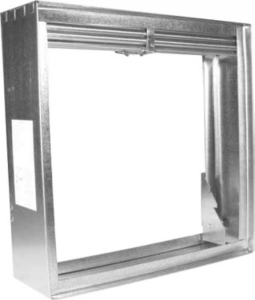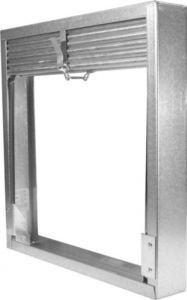How does an HVAC fire damper work? An HVAC fire damper is a crucial safety device installed within ventilation systems to restrict the spread of fire and smoke in a building. Here’s how it works:
Heat-Triggered Closure:
- Fire dampers are essentially automatic fire doors within the ductwork. They remain open during normal operation to allow airflow.
- However, they are designed to close automatically upon detecting a significant rise in temperature. This rise typically signifies a fire event.
Two Main Types:
There are two primary categories of fire dampers, each with a distinct closing mechanism:
-
Dynamic Fire Dampers: These are typically installed in vertical walls or shafts. They use a spring mechanism that keeps the damper open during normal operation. In the event of a fire, a fusible link containing a low-melting-point metal alloy melts due to the rising heat. This releases the tension on the spring, causing the damper to slam shut. An air pressure system may also be used to keep the damper open during normal operation and trigger its closure upon fire detection.

-
Static Fire Dampers: These are generally found in horizontal ceilings or floors. Static fire dampers rely on gravity to close. They use a weighted blade or damper door that is held open by a fusible link during normal operation. When the fire causes the link to melt, the blade or door falls due to gravity, effectively blocking the duct opening.

Overall Function:
Regardless of the specific closing mechanism, the primary function of an HVAC fire damper is to:
- Normal Operation: During normal conditions, the fusible link is intact, and the damper remains open. Air can flow freely through the ductwork, unobstructed.
- Fire Detection: When a fire erupts, the temperature in the ductwork rises significantly.
- Fusible Link Melts: The fusible link, designed to melt at a predetermined temperature, weakens due to the heat.
- Damper Closure: In a dynamic fire damper, the spring mechanism is released, causing the damper to shut automatically. In a static fire damper, the fusible link melts, allowing the damper blade or door to fall due to gravity, blocking the duct opening.
- Fire Containment: The closed damper restricts the passage of flames, smoke, and hot gases through the ductwork, preventing them from spreading to other areas of the building.
Additional Points:
- Fire dampers require regular inspection and maintenance to ensure they function properly in case of a fire.
- Building codes mandate the installation of fire dampers in specific locations within HVAC systems. A qualified HVAC consultant can advise on +91 9825636606 Today the specific requirements for your building.
By automatically closing during a fire, HVAC fire dampers play a vital role in building safety. They help compartmentalize the fire, protect occupants, and give firefighters more time to control the blaze.
